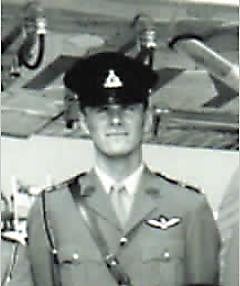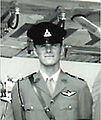Werry, Steve D
| Steve D Werry | |
|---|---|
 | |
| Allegiance | Canada |
| Service/branch | Canadian Army |
| Rank | Major |
| Awards | CD |
His Pilot’s Story[1]
My total time was just over 1700 hrs, starting in 1957 (while on summer training with the Petawawa Sig Tp) at Browns Airport in Pembroke on an Aeronca, continuing on at the Primary Training School, Centralia in Feb 1961 with the Chipmunk and then moving on to Rivers (Canadian Joint Air Training Centre) with the Air Support Signal Troop and attending the Light Aircraft School Course # 31 (Advanced Flying Phase) conducted on the L-19 After completing the course, I joined the Basic Helicopter Training Unit in Dec, with its newly received CH112 helicopters. We were the 'guinea pigs' for the machine as it related to cold weather operations, with the fortunate result that the training schedule was interspersed with several unplanned breaks (and subsequent car trips with the other single pilots to the hinterlands of Mexico). The course finished in May 1962, some went on to the instrument school, others went back to regimental duty and I ended up with the Sig Regt in the Congo (ONUC). While in Leopoldville. I found a PA-22 Piper Tri-Pacer that was available for hire, so on the basis of my Canadian Private Pilots License, I acquired a Republic of the Congo PPL. The machine was then rented for a weekend trip to Matadi (pax included George Simpson and Don Kidd). The flight went without incident until we landed at Moanda (on the return) and spent some considerable time (and money) convincing the airport guards to release a needed 45 gal drum of avgas. In Dec 62, I moved on to UNEF and the Camp Rafah/Gaza complexes. Maj. Ken Grace processed my 'continuation flying' ticket at the Flying Club of Lebanon and by the end of Jan 63, I was doing circuits in a Cessna 150 at Beirut Airport. This proved rather dull, so I wrote my PPI, exam, and got my Lebanese license.
Capt. Colin Gillis (RCASC) and I teamed up to explore the nearby countries, flying into Syria and to Cyprus on separate occasions. Returning to Canada in Feb 64, I moved to Gagetown and resumed flying with the Flying Club of St. John. The allocated aircraft was again a PA-22 but with a long-range tank that enabled a run from Fredericton direct to Montreal. That destination was a popular one, always having a full complement of paxs, with many from 3 Sig Sqn. Typical of the Maritimes, was one return when a (unforecast) fogbank rapidly formed and moved inland. It blocked out/closed first St John, then Fredericton and then everything else. We were into our fuel reserves due to headwinds and were rapidly running out of daylight. By chance one of our pax glimpsed a portion of Blissville Airport (which since has had a special place in my heart) through a hole, and we got down without further difficulty.
In 1966, I went to the RCS of S as an instructor prior to attending the CASC. I purchased an elderly Cessna 195 and carried on with my flying on a private basis. The Cessna 195 was one of the great airplanes, she was first used as a USAF instrument trainer and for liaison duties, and later by the Saskatchewan Air Ambulance Service. In her later life, she ferried supplies into very remote areas. The 195 was unlike any other aircraft ever made-built like a rock, she was fast, filled a goodly load and was a dream to fly. I adored that bird, and the flight pay I received in the 70's went toward its upkeep. Flights included destinations to Venezuela and Columbia, Haiti (twice) the Bahamas, Florida and east coast USA (several trips), Midwest USA, Mexico and the Yucatan (three trips), Turks and Caicos Islands, and of course, many shorter legs within Ontario, Quebec and the Maritimes. To make things easier, I acquired my US and Canadian Class II instrument ratings, and undertook all of the servicing and basic maintenance on the engine, avionics and airframe. Some 1000 hours were flown in the 195, and the memories are innumerable from a near fire-fight at Port-au-Prince Airport in Haiti where she was used as a shield by a squad of republican troops, to withstanding a ground loop in Caracas, to losing all electrics during an IFR flight with a descent through icing to what turned out to be warmer minimums, and on and on. She was sold in 1978 when the costs of maintenance and services began to escalate beyond what could be carried, and I with great regret, closed the door on this magnificent machine and on my days in the air.
Related Pages
- No related pages at this time
